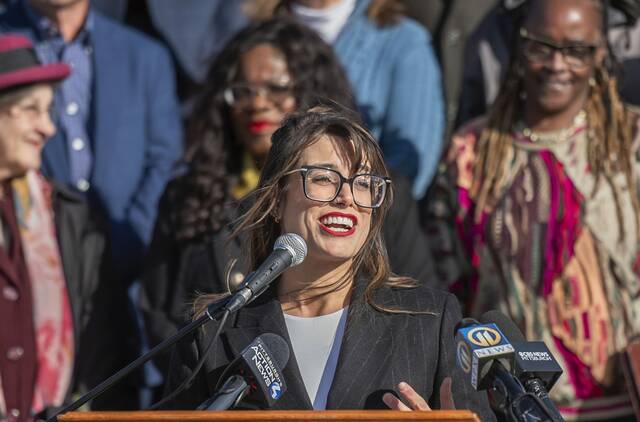Innamorato defends proposed budget and Allegheny County tax increase
Allegheny County Executive Sara Innamorato defended her budget and proposed tax increase Wednesday, arguing that boosting the county’s tepid economic growth is more important than making large budget cuts.
Innamorato in October proposed a 46.5% property tax hike to help balance her $3.1 billion budget, which will have a shortfall of more than $100 million if the revenue disparity is not addressed.
The proposed rate hike from 4.73 mills to 6.93 mills, coupled with a boost in the homestead exemption, would increase annual property taxes by roughly $182 — or about $15 more a month — on a house assessed at the county’s median value of $110,400.
That proposal received immediate pushback from County Council members, who acknowledged that property taxes must increase to cover the budget deficit but said Innamorato’s rate is too high.
Innamorato at a news conference in Braddock on Wednesday said deep cuts won’t solve Allegheny County’s long-term problems. The only way to keep property taxes stable is to use county funds to boost the region’s slow economic growth, she said.
“We are not going to continue to starve ourselves. We are going to grow,” Innamorato said.
Her budget proposes to allocate $100 million to economic development efforts in the county. Those funds would be split up to fund infrastructure improvement for communities’ Main Streets, remove blight, attract businesses in the clean energy, manufacturing and tech sectors and give financial support to first-time homebuyers and entrepreneurs.
It would be the first time the county is earmarking operating funds for the economic development department, which has been funded solely by federal matches. Innamorato is proposing allocating $2.6 million out of the operating budget for economic development. The remaining $97 million investment is from state and federal grants, as well as other capital projects.
She noted that Allegheny County has one of the slowest economic rebounds coming out of the pandemic in the country. An investment now will bear fruit down the line, Innamorato said.
“I know what is at stake if we do not invest in Allegheny County,” she said. “If we do double down on economic growth, that means more people and businesses are helping to fund the necessary services that Allegheny County provides.”
The backdrop of Innamorato’s press conference was the Braddock Civic Plaza, a symbol of county investment used to try to boost economic development.
The plaza opened five years ago on the former site of the UPMC Braddock hospital, which closed in 2010 and signaled massive decline for the borough.
Now, local leaders say, the square is surrounded by new housing and a revitalized business district that includes a popular craft brewery and Mexican restaurant, Brassero Grill.
Braddock Council President LuJuan Reeves said the county’s investment in Braddock has brought new properties and businesses onto the borough’s tax rolls.
Critics, though, say that the county should tighten its belt and make big cuts when facing a shrinking tax base.
County Manager John Fournier recently warned council members opposed to Innamorato’s suggested 2.2-mill tax increase that avoiding such a hike would be difficult without severe cuts.
Fournier said the consequences could include closing all four county pools; eliminating after-school programs for thousands of children; and laying off hundreds of workers, including police officers, 911 dispatchers, health care professionals, park rangers and snowplow drivers.
Innamorato said Allegheny County must invest to attract business growth, and communities across Western Pennsylvania have had to raise property taxes because of shrinking tax bases, inflation and declining revenue sources.
Westmoreland County, for instance, raised its property taxes by 32.5% last year.
She said Allegheny County needs to invest, not cut, its way to economic prosperity. That strategy could keep property taxes stable into the future and potentially lower them if growth is extremely robust.
“Where you have higher levels of vacancy, you often have higher tax rates and more of a burden on those residents who stick through the tough times,” Innamorato said. “If we grow as a region, if we create more homeowners, then fewer people are bearing the burden.”
Council President Pat Catena, D-Carnegie, has said Innamorato doesn’t have the 10 votes needed to pass her budget proposal, but he also hasn’t detailed what kind of tax increase council would be willing to support.
Innamorato was joined at the news conference by Councilwoman Anita Prizio, D-O’Hara. Innamorato said she is confident that enough council members will come around to her side.
“We know that that majority of County Council members want a budget that puts the county on solid financial footing, and they want to continue to invest in our growth as a region,” Innamorato said.
Ryan Deto is a TribLive reporter covering politics, Pittsburgh and Allegheny County news. A native of California’s Bay Area, he joined the Trib in 2022 after spending more than six years covering Pittsburgh at the Pittsburgh City Paper, including serving as managing editor. He can be reached at rdeto@triblive.com.
Remove the ads from your TribLIVE reading experience but still support the journalists who create the content with TribLIVE Ad-Free.

